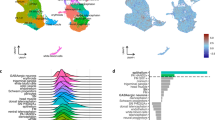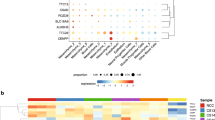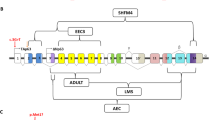Abstract
Mice with a deletion of Tgf-β3 (−/−) and association studies in humans of different ethnicities support the involvement of TGFB3 in the etiology of orofacial clefts. In this study, we investigated the relevance of TGFB3 in the development of cleft lip and palate (CL/P) among 204 triads of central European origin. Transmission-disequilibrium test (TDT) analysis revealed no significant transmission distortions for each marker alone, and none for any possible haplotypes. However, we found strong evidence for parent-of-origin effects, with lower risk of maternal transmission compared with paternal transmission [I M = 0.38; confidence interval (CI): 0.17–0.86] of the risk allele T to an affected offspring at marker rs2300607. This is also expressed in an increased risk of heterozygous children having the T allele inherited from the father (R P = 3.47; CI: 1.32–9.11). Our data support the involvement of TGFB3 in the development of oral clefts in patients of central European origin.
Similar content being viewed by others
Log in or create a free account to read this content
Gain free access to this article, as well as selected content from this journal and more on nature.com
or
References
Baroni T, Carinci P, Bellucci C, Lilli C, Becchetti E, Carinci F, Stabellini G, Pezzetti F, Caramelli E, Tognon M, Bodo M (2003) Cross-talk between interleukin-6 and transforming growth factor-beta3 regulates extracellular matrix production by human fibroblasts from subjects with non-syndromic cleft lip and palate. J Periodontol 74:1447–1453
Beaty TH, Wang H, Hetmanski JB, Fan YT, Zeiger JS, Liang KY, Chiu YF, Vanderkolk CA, Seifert KC, Wulfsberg EA, Raymond G, Panny SR, McIntosh I (2001) A case-control study of nonsyndromic oral clefts in Maryland. Ann Epidemiol 11:434–442
Beaty TH, Hetmanski JB, Zeiger JS, Fan YT, Liang KY, VanderKolk CA, McIntosh I (2002) Testing candidate genes for non-syndromic oral clefts using a case-parent trio design. Genet Epidemiol 22:1–11
Becker T, Knapp M (2004) A powerful strategy to account for multiple testing in the context of haplotype analysis. Am J Hum Genet 75:561–570
Birnbaum S, Reutter H, Mende M, Díaz-Lacava A, Henschke H, Bergé SJ, Braumann B, Lauster C, Hemprich A, Wenghoefer M, Saffar M, Reich RH, Scheer M, Kramer F-J, Knapp M, Mangold E (2007) A family-based association study in central Europeans: no evidence for the cystathionine beta-synthase c.844ins68 gene variant as a risk factor for non-syndromic cleft lip and palate. Am J Med Genet A 143:205–207
Britto JA, Evans RD, Hayward RD, Jones BM (2002) Toward pathogenesis of Apert cleft palate: FGF, FGFR, and TGF beta genes are differentially expressed in sequential stages of human palatal shelf fusion. Cleft Palate Craniofac J 39:332–340
Blavier L, Lazaryev A, Groffen J, Heisterkamp N, DeClerck YA, Kaartinen V (2001) TGF-beta3-induced palatogenesis requires matrix metalloproteinases. Mol Biol Cell 12:1457–1466
Gato A, Martinez ML, Tudela C, Alonso I, Moro JA, Formoso MA, Ferguson MW, Martinez-Alvarez C (2002) TGF-beta(3)-induced chondroitin sulphate proteoglycan mediates palatal shelf adhesion. Dev Biol 250:393–405
Hager R, Cheverud JM, Wolf JB (2008) Maternal effects as the cause of parent-of-origin effects that mimic genomic imprinting. Genetics 178:1755–1762
Ichikawa E, Watanabe A, Nakano Y, Akita S, Hirano A, Kinoshita A, Kondo S, Kishino T, Uchiyama T, Niikawa N, Yoshiura K (2006) PAX9 and TGFB3 are linked to susceptibility to nonsyndromic cleft lip with or without cleft palate in the Japanese: population-based and family-based candidate gene analyses. J Hum Genet 51:38–46
Jirtle RL, Sander M, Barrett JC (2000) Genomic imprinting and environmental disease susceptibility. Environ Health Perspect 108:271–278
Jugessur A, Lie RT, Wilcox AJ, Murray JC, Taylor JA, Saugstad OD, Vindenes HA, Abyholm F (2003) Variants of developmental genes (TGFA, TGFB3, and MSX1) and their associations with orofacial clefts: a case-parent triad analysis. Genet Epidemiol 24:230–239
Kaartinen V, Voncken JW, Shuler C, Wartburton D, Bu D, Heisterkamp N, Groffen J (1995) Abnormal lung development and cleft palate in mice lacking TGF-beta 3 indicates defects of epithelial-mesenchymal interaction. Nat Genet 11:415–421
Kim MH, Kim HJ, Choi JY, Nahm DS (2003) Transforming growth factor-beta3 gene SfaN1 polymorphism in Korean nonsyndromic cleft lip and palate patients. J Biochem Mol Biol 36:533–537
Lidral AC, Murray JC, Buetow KH, Basart AM, Schearer H, Shiang R, Naval A, Layda E, Magee K, Magee W (1997) Studies of the candidate genes TGFB2, MSX1, TGFA, and TGFB3 in the etiology of cleft lip and palate in the Philippines. Cleft Palate Craniofac J 34:1–6
Lidral AC, Romitti PA, Basart AM, Doetschman T, Leysens NJ, Daack-Hirsch S, Semina EV, Johnson LR, Machida J, Burds A, Parnell TJ, Rubenstein JL, Murray JC (1998) Association of MSX1 and TGFB3 with nonsyndromic clefting in humans. Am J Hum Genet 63:557–568
Maestri NE, Beaty TH, Hetmanski J, Smith EA, McIntosh I, Wyszynski DF, Liang KY, Duffy DL, Vanderkolk C (1997) Application of transmission disequilibrium tests to nonsyndromic oral clefts: including candidate genes and environmental exposures in the models. Am J Med Genet 73:337–344
Mitchell LE, Murray JC, O’Brien S, Christensen K (2001) Evaluation of two putative susceptibility loci for oral clefts in the Danish population. Am J Epidemiol 153:1007–1015
Morkūniené A, Steponaviciūt D, Utkus A, Kucinskas V (2007) Few associations of candidate genes with nonsyndromic orofacial clefts in the population of Lithuania. J Appl Genet 48:89–91
Nogai H, Rosowski M, Grün J, Rietz A, Debus N, Schmidt G, Lauster C, Janitz M, Vortkamp A, Lauster R (2008) Follistatin antagonizes transforming growth factor-beta3-induced epithelial-mesenchymal transition in vitro: implications for murine palatal development supported by microarray analysis. Differentiation 76(4):404–416
Proetzel G, Pawlowski SA, Wiles MV, Yin M, Boivin GP, Howles PN, Ding J, Ferguson MW, Doetschman T (1995) Transforming growth factor-beta 3 is required for secondary palate fusion. Nat Genet 11:409–414
Romitti PA, Lidral AC, Munger RG, Daack-Hirsch S, Burns TL, Murray JC (1999) Candidate genes for nonsyndromic cleft lip and palate and maternal cigarette smoking and alcohol consumption: evaluation of genotype-environment interactions from a population-based case-control study of orofacial clefts. Teratology 59:39–50
Rubini M, Brusati R, Garattini G, Magnani C, Liviero F, Bianchi F, Tarantino E, Massei A, Pollastri S, Carturan S, Amadori A, Bertagnin E, Cavallaro A, Fabiano A, Franchella A, Calzolari E (2005) Cystathionine beta-synthase c.844ins68 gene variant and non-syndromic cleft lip and palate. Am J Med Genet A 136:368–372
Sato F, Natsume N, Machido J, Suzuki S, Kawai T (2001) Association between transforming growth factor beta 3 and cleft lip and/or palate in the Japanese population. Plast Reconstr Surg 107:1909–1910
Scapoli L, Martinelli M, Pezzetti F, Carinci F, Bodo M, Tognon M, Carinci P (2002) Linkage disequilibrium between GABRB3 gene and nonsyndromic familial cleft lip with or without cleft palate. Hum Genet 110:15–20
Slayton RL, Williams L, Murray JC, Wheeler JJ, Lidral AC, Nishimura CJ (2003) Genetic association studies of cleft lip and/or palate with hypodontia outside the cleft region. Cleft Palate Craniofac J 40:274–279
Spielman RS, McGinnis RE, Ewens WJ (1993) Transmission test for linkage disequilibrium: the insulin gene region and insulin-dependent diabetes mellitus (IDDM). Am J Hum Genet 52:506–516
Suzuki Y, Jezewski PA, Machida J, Watanabe Y, Shi M, Cooper ME, Viet le T, Nguyen TD, Hai H, Natsume N, Shimozato K, Marazita ML, Murray JC (2004) In a Vietnamese population, MSX1 variants contribute to cleft lip and palate. Genet Med 6:117–125
Tanabe A, Taketani S, Endo-Ichikawa Y, Tokunaga R, Ogawa Y, Hiramoto M (2000) Analysis of the candidate genes responsible for non-syndromic cleft lip and palate in Japanese people. Clin Sci (Lond) 99:105–111
van den Oord EJ, Vermunt JK (2000) Testing for linkage disequilibrium, maternal effects, and imprinting with (In)complete case-parents triads, by use of the computer program LEM. Am J Hum Genet 66:335–338
Vermunt JK (1997) LEM: a general program for the analysis of categorical data. Tilburg University, Tilburg
Vieira AR, Orioli IM, Castilla EE, Cooper ME, Marazita ML, Murray JC (2003) MSX1 and TGFB3 contribute to clefting in South America. J Dent Res 82:289–292
Weinberg CR, Wilcox AJ, Lie RT (1998) A log-linear approach to case-parent-triad data: assessing effects of disease genes that act either directly or through maternal effects and that may be subject to parental imprinting. Am J Hum Genet 62:969–978
Weinberg CR (1999) Methods for detection of parent-of-origin effects in genetic studies of case-parents triads. Am J Hum Genet 65:229–235
Weir BS (1996) Genetic data analysis II. Sinauer, Sunderland
Acknowledgments
We thank all participants for consenting to the study and providing blood samples. We are grateful to Birgit Kroschel-Lang, Charlotte Opitz, Michael Krimmel, and the German Support Group for People with Cleft Lip and/or Palate (Selbsthilfevereinigung für Lippen-Gaumen-Fehlbildungen e.V. Deutschland) for kind support in contacting patients. The authors also thank Susanne Raeder for skilful help with laboratory work. This study was supported by a grant from the Deutsche Forschungsgemeinschaft (DFG) to EM and FJK (FOR 423 Genetic Epidemiology and Medical Genetics of Complex Diseases, Project N1).
Author information
Authors and Affiliations
Corresponding author
Rights and permissions
About this article
Cite this article
Reutter, H., Birnbaum, S., Mende, M. et al. TGFB3 displays parent-of-origin effects among central Europeans with nonsyndromic cleft lip and palate. J Hum Genet 53, 656–661 (2008). https://doi.org/10.1007/s10038-008-0296-9
Received:
Accepted:
Published:
Issue date:
DOI: https://doi.org/10.1007/s10038-008-0296-9
Keywords
This article is cited by
-
Genome-wide analysis of parent-of-origin effects in non-syndromic orofacial clefts
European Journal of Human Genetics (2014)
-
Intra-amniotic Transient Transduction of the Periderm With a Viral Vector Encoding TGFβ3 Prevents Cleft Palate in Tgfβ3−/− Mouse Embryos
Molecular Therapy (2013)
-
Contribution of MSX1 variants to the risk of non-syndromic cleft lip and palate in a Malay population
Journal of Human Genetics (2011)
-
Maternal transmission effects of the PAX genes among cleft case–parent trios from four populations
European Journal of Human Genetics (2009)



